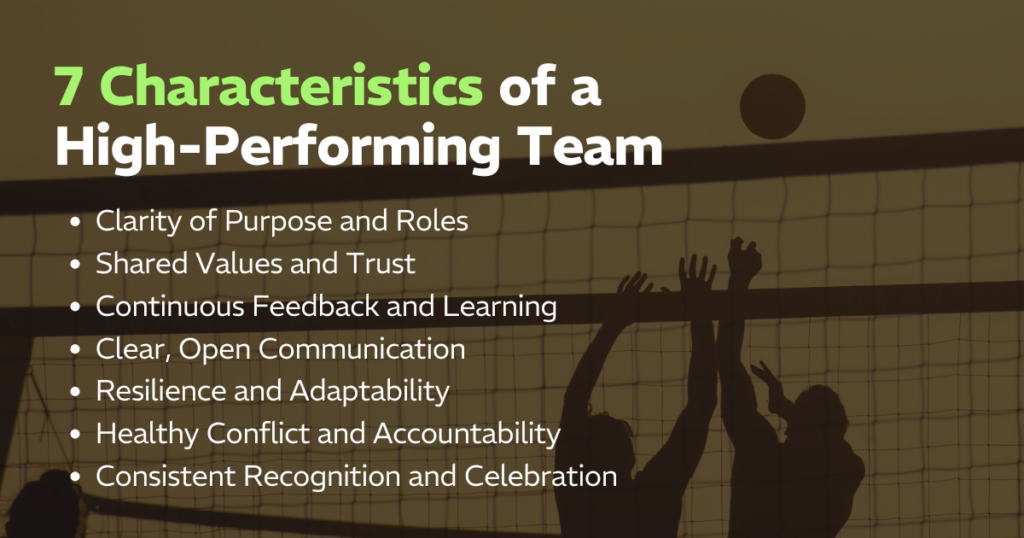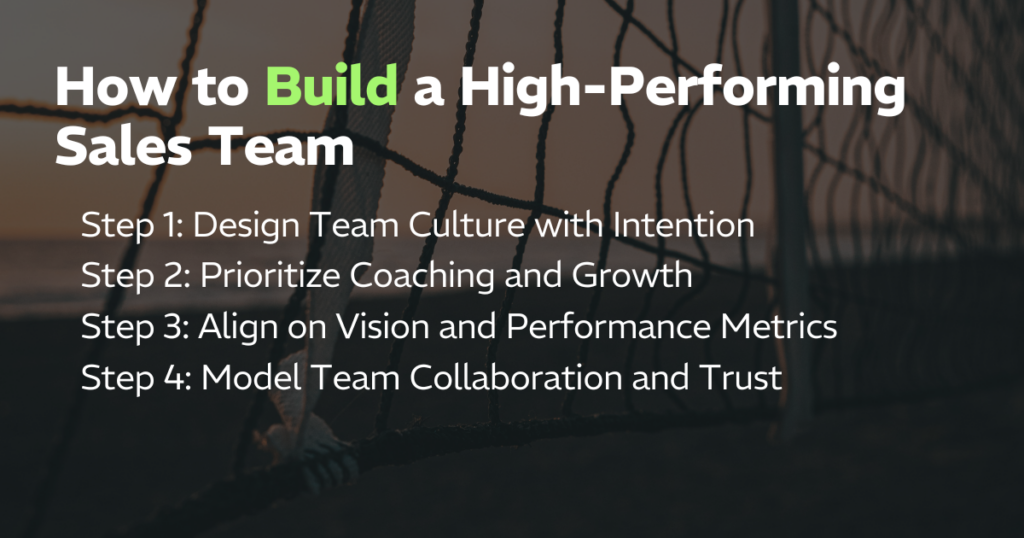Learning how to build a high-performing team is part mindset, part muscle—and it’s one of the most important things a leader can do.
I’ve seen teams of talented individuals struggle because expectations were vague, trust was low, or the culture didn’t support real collaboration. On the flip side? I’ve watched teams whose members had average resumes deliver extraordinary results—because the environment brought out their best.
High performance doesn’t happen by accident. It’s built—on clarity, connection, and consistent leadership. Here’s how you can create that.
What Is a High-Performing Team?
A high-performing team is a group of people who consistently achieve exceptional results together. Great teams will always outperform even the most talented individuals in isolation. Your team’s success stacks up when everyone practices deep alignment, trust, and shared accountability.
Whether it’s a high-performing executive team, a sales organization, or any other department, the characteristics of successful teams are consistent:
- Aligned around a common mission, shared values, and clear priorities.
- Committed to high standards and continuous improvement
- Built on strong relationships, open communication, and mutual respect
- Adaptable in the face of challenge and change
Great teams don’t happen by chance. They’re intentionally cultivated by leaders who clearly define expectations, foster a culture of psychological safety, and set up every team member to be their best. Not only do these leaders know what makes a high-performing team tick, they nurture it every day.
7 Characteristics of a High-Performing Team
What makes a high-performing team? In my experience, intention matters. Success comes down to shared behaviors and beliefs that elevate how people show up for each other—and for the mission.
I’ve had the privilege to step inside some extraordinary organizations. These are cultures where people are deeply connected to their work, each other, and the outcomes they create. It’s a different energy.
If you want to practice human-centered sales leadership, here are some common characteristics you’ll want to embrace.
Clarity of Purpose and Roles
Every team member should be able to answer three questions:
- Why does this team exist?
- What does success look like?
- How do I contribute to it?
When people are clear on purpose and position day to day, they can execute with confidence. Ambiguity slows down teams. Clarity speeds them up.
This is how you unlock individual and team momentum. It’s also where team development really begins.
Shared Values and Trust
Culture is built one moment of trust at a time. But there’s no shortcut to building trust in high-performing teams. Leaders and team members earn each other’s trust by listening, following through, and showing up for each other when it matters.
The best teams I’ve seen operate with psychological safety. They can challenge each other without fear. They share credit. They hold each other accountable while always showing respect.
Trust isn’t soft. It’s a performance accelerator.
Continuous Feedback and Learning
Growth is never one-and-done.
The best teams are constantly evolving. They learn quickly. They course-correct without ego. They embrace continuous learning, openly exchanging feedback as a core practice rather than as a formality.
These team dynamics start with the leader. When you model coachability and make feedback safe, your people lean into growth. That’s how you build a continuous learning culture that wins.
Clear, Open Communication
Ambiguity disrupts teams. Clear and open communication empowers them. High-performing teams do more than just talk, however. They communicate with intention. They ask better questions. They strive for clarity and check for understanding.
Open communication is a differentiator for team effectiveness. It prevents drift. It builds alignment. And it moves the mission forward, every single day.
Resilience and Adaptability
Challenge is a constant. Your team’s mindset toward it is what counts.
High-performing teams respond rather than react. They stay grounded in purpose, even when priorities shift. They lean into change with curiosity instead of resistance.
This mindset doesn’t appear by chance. It’s cultivated by team leaders who model resilience, give their teams room to grow, and normalize healthy recovery when things get tough.
Healthy Conflict and Accountability
When people care deeply about outcomes, disagreement is inevitable. That’s a good thing. Healthy conflict leads to better decisions. Better decisions lead to better results and more innovation.
High-performing teams hold themselves accountable because they respect each other and are genuinely committed to shared goals. Accountability is woven into the team’s culture, motivating everyone to follow through. Team members are competitive, but not against each other. They want to do great work together and elevate the organization.
Consistent Recognition and Celebration
Recognition fuels performance. Don’t underestimate the power of a genuine thank-you or shout-out. Culture is built in those moments.
When you acknowledge what’s working, people do more of it. Celebrate the little wins. Highlight progress and effort. You’ll see how quickly you build and sustain the team’s energy and loyalty. You’ll also reinforce the behaviors you want to see repeated.

How to Build a High-Performing Sales Team
Sales performance is a leadership responsibility.
Your sales team will model what they see at the top. If the executive team is aligned, focused, and collaborative, that culture flows down throughout the organization. On the other hand, if your executive team is misaligned, confused about goals, or shows friction, you’ll see those behaviors show up in your sales team, too.
Want to build a high-performing sales team? Start with how you show up as a leadership team.
Design Your Team Culture With Intention
Don’t leave culture to chance. Design it.
That means defining values, setting expectations, and holding the line on behaviors. Your team culture should be felt in team meetings, in one-on-ones, and in how you navigate challenges.
Be intentional in forming a culture that expects top performers to sell with clarity and conviction.
Prioritize Coaching and Growth
Great sales leaders are great performance coaches.
The best sales cultures understand the power of coaching to improve how your team works. Make sales coaching consistent and part of everyone’s development plan. Focus on future growth, not past mistakes. Tie this training directly to personal and professional growth, helping your sales team buy in.
Align on Vision and Performance Metrics
The cost of misalignment is lost time and trust. Be clear about what success looks like and how it’s measured. Defining common goals allows your team to focus, self-correct, and celebrate progress together.
When metrics are tied explicitly to the mission, performance becomes predictable, repeatable, and scalable.
Encourage Collaboration and Trust
Trust is contagious. So is dysfunction.
If you want your sales team to trust each other, challenge one another productively, and engage in genuine team collaboration, you must model it as the sales leader.
Break down silos. Make space for voices. Share the spotlight. That’s the kind of leadership that builds performance cultures.

What Peak Performance Looks Like Inside Teams
I’ve worked with countless organizations to improve sales team performance. Real change starts with how we lead.
Leaders who foster a culture of continuous learning see their teams gain greater confidence and clarity. By regularly addressing specific skills—like objection handling, storytelling, or aligning around shared goals—teams improve steadily and predictably over time.
Teams building toward the future know exactly what’s expected, how success is measured, and how their contributions fit into the organization’s goals. With goal clarity, teams can focus on the right work while holding each other accountable.
As I explain in my human-centered leadership keynote, developing a high-performing team requires empowering your people, aligning them on shared goals, and reigniting their sense of possibility.
Ready to Build Your High-Performing Team?
You probably don’t need more hustle from your team. You need better alignment. Remember these core principles and apply them with intention: clarity of purpose, shared values, psychological safety, open communication, healthy conflict, coaching, accountability, and recognition.
Learning how to build a high-performing team is one of the most powerful contributions you’ll make as a leader. It’s your culture. Your legacy. Your competitive edge. And it starts by making the choice to lead differently.
Book the Human-Centered Leadership keynote and learn how to build a high-performing team from the inside out.



![[RYAN] Featured Image - Change Management Skills Winding Architecture](https://ryanestis.com/wp-content/uploads/bb-plugin/cache/RYAN-Featured-Image-Change-Management-Skills-1024x538-panorama-7395bbf10c2a8d43958959443e02cbb1-.png)

![[RYAN] Featured_Leadership Development Planning for Human Centered Growth Group climbing a hill together](https://ryanestis.com/wp-content/uploads/bb-plugin/cache/RYAN-Featured_Leadership-Development-Planning-for-Human-Centered-Growth-1024x538-panorama-ba61edeb5d6c961b544c5c7916ed5ca0-.png)





